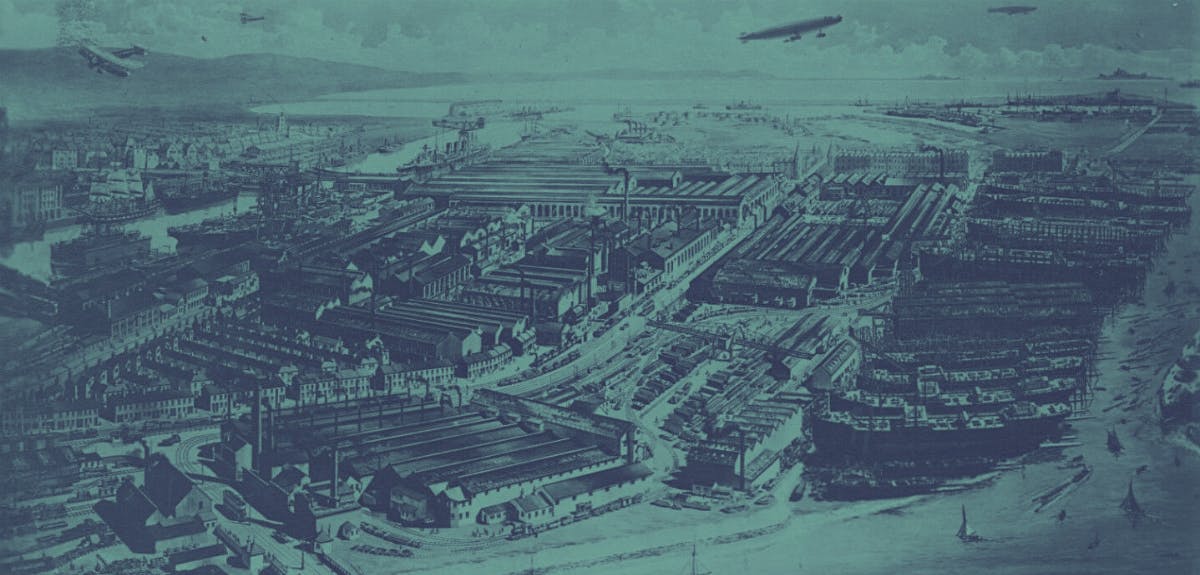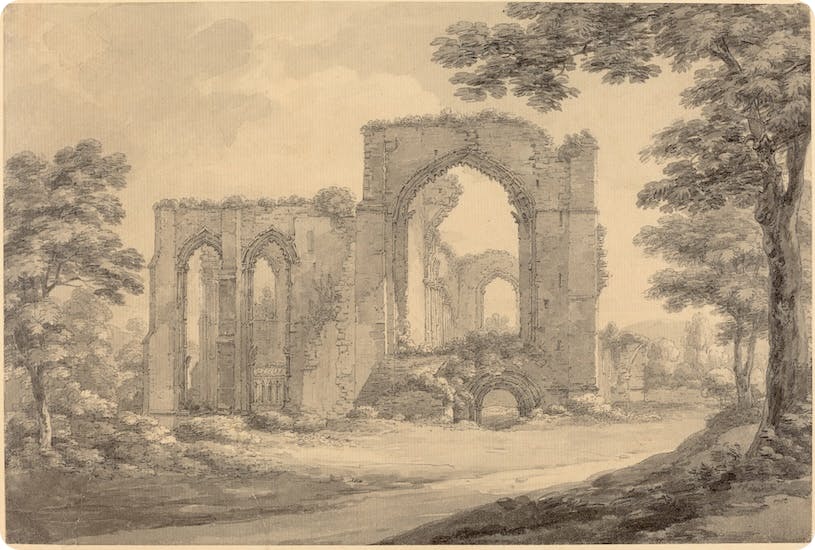The history of the Barrow-in-Furness Shipyard
7-8 minute read
By Charlotte Ward Kelly | July 15, 2024

Charlotte Ward-Kelly takes a deep-dive into the story behind this historic industrial centre.
The shipyard at Barrow-in-Furness, a port town in Cumbria, has been at the heart of British shipbuilding and industry since it was opened in 1871.
The hardworking men and women of the shipyard built some of the most famous and significant maritime and naval vessels in history and were at the forefront of marine innovation.
Barrow's early history
Located on the northwest coast of England in Cumbria, there is evidence of a population in the Barrow area dating back to the Vikings and Romans. In 1123, Furness Abbey was founded by Stephen, Count of Boulogne.

Furness Abbey, c.1777.
By the 15th century, it had become the second wealthiest and most powerful monastery in the country, after Fountains Abbey in Yorkshire. This was largely due to the monks of the Abbey finding iron ore, which were mined and traded.
The industrialisation of Barrow
In the 19th century, Henry Schneider, found here in the 1861 census as an ‘iron master’, founded the Furness Railway in Barrow along with other investors. Its purpose was to transport large deposits of iron ore to quarries in the surrounding areas.
In addition to mining, steelworks and other industries were added to the area.
These sweeping infrastructural changes led to a significant rise in the population of Barrow-in-Furness, which spiked from a few hundred to over 18,000 at the time of the 1871 Census.

Barrow-in-Furness, Wikipedia.
A planned town was proposed by Sir James Ramsden, a local industrialist and managing director of the Furness Railway Company. Ramsden served as the town’s first mayor when it achieved municipal borough status in 1867.
Barrow Docks and the Barrow Shipbuilding Company
To support the increased demand and work in the area, work began on the Barrow Docks in the early 1860s. Realising the strong shipbuilding potential, James Ramsden set up the Barrow Shipbuilding Company in 1871 and immediately set about building vessels.

Barrow Shipbuilding Company British Newspapers Archive
The first vessels launched at Barrow were the steam-powered Aries and Sir James Ramsden (named in honour of the knighthood he received in 1872). These were smaller vessels, likely privately used by Ramsden and his family.

James Ramsden.
Barrow shipyard grew significantly up to the 1880s, building over 100 ships and receiving orders regularly from companies including P&O and the Inman Line. One of the most famous ships to launch during this period was the City of Rome, a British passenger line.
At 8,453 tonnes, she was designed to be the largest and fastest ocean liner in the world. However, after only eight crossings, she was returned to Barrow and rejected by the Inman Line as she did not meet the minimum cargo requirements.

RMS City of Rome, Wikipedia.
Despite disappointment over the City of Rome, Barrow continued to grow. In the 1880s, Barrow Shipyard built its first submarine, the Nordenfelt 2, designed by Swedish inventor Thorsten Nordenfelt. This began Barrow’s long history of designing and building submarines.
The Naval Construction and Armaments Co takeover
In 1888, Barrow Shipbuilding Company was taken over by the Naval Construction and Armaments Co, which kickstarted the construction of naval vessels and armaments at Barrow.
During this period, HMS Juno was built in the yard and was launched in 1895. Juno made history in 1899 after relaying a message from HMS Europa to HMS Alexandra at a distance of over 95 miles, the longest ship transmission at the time.

HMS Juno, Wikipedia.
In 1901 she formed part of a naval escort of the Duke and Duchess of Cornwall and York during their tour of the British Empire and took part in the coronation fleet review in 1902.
Sir James Ramsden died in 1896. He was an influential figure in Barrow and Cumbria as well as in British industry and shipbuilding - his loss was undoubtedly felt by all who lived and worked at Barrow-in-Furness.
Vickers, Maxim and Company
The British engineering company Vickers, Sons & Company absorbed the Naval Construction and Armaments Company in 1897 - becoming Vickers, Sons and Maxim. Wanting to be one of the biggest and most successful shipbuilding companies in the world, Vickers noted the lack of skilled labour in Barrow, attributed to poor housing and living conditions.
Many workers were living on the SS Alaska, a ship moored inside the docks. Vickers purchased a plot of land on Walney Island and built Vickerstown in 1901. Walney Bridge was added in 1908 to help workers travel to work. This led to an influx of skilled labourers from the surrounding areas and overseas.

Vickerstown, Wikipedia.
The shipyard and shipbuilding would have dominated life in Barrow and Vickerstown. As well as employing a significant number of the local population, residents would have seen these remarkable structures be built over time and witnessed them launch into the sea.
Barrow-in-Furness during the First World War
By 1914, Barrow had become one of the busiest shipyards in Britain. As well as building ships for the Royal Navy, the yard also received orders from the navies of Russia, Brazil, Japan, India, and Argentina.
It wasn’t unusual for countries around the world to have ships built in Britain, often noting the British skills in ship construction. Barrow had built close to 100 vessels, 64 of which were submarines, by 1914.
The construction of ships and armaments was paramount for the war effort so production could not slow at Barrow. Though shipping and shipbuilding was a protected profession, thousands of men from the shipyard still joined the war effort.
The yard needed to replace the men who had gone to war and to support the demands on the yard. Migration brought huge numbers of temporary craftsmen and labourers to the yard.
The workforce at Barrow grew to over 30,000 during the war, producing millions of shells, shipping, and ordnance. Barrow was one the most productive shipyards in the county and was vital to the war effort.
As with industry across the country, women were brought into the shipyard for work. Over 1,240 women were employed in industrial roles, the majority of whom were teenagers.
Elizabeth Atkinson went to work at Barrow Shipyard aged 16. Her record indicates that she worked on airships. In the 1921 Census, we find Elizabeth still employed at Barrow. By this point, she's a balloon builder.
The Shipyard under attack
Given its strategic importance, Barrow gained the attention of the German Navy. On 29 January 1915, U-21 appeared in the water off Walney Island. Submarines were a common site in the shipyard so initially, U-21 was ignored.

The King and Queen visited in 1917 British Newspaper Archive
However, once she opened fire on the yard, locals took notice. A group from the Lancashire and Cheshire Royal Gallery Artillery, who were manning the fort, returned fire. U-21 disappeared and the shipyard, its workers and the residents were saved.
Barrow during the Second World War
As with the First World War, Barrow Shipyard was vital to the war effort from 1939, producing over 100 vessels, ships, and submarines including aircraft carriers HMS Illustrious and HMS Indomitable.

RMS Orion, Wikipedia.
Due to Barrow’s strategic value, the town and shipyard once again became a target for the German air force. Between 1941 and 1942, Barrow faced several air raids. Remarkably, though over 11,000 houses were damaged, there were only 87 casualties.
Into the twenty-first century
After the Second World War, there was a slump in industry in Barrow with the closure of the Barrow Ironworks and the Furness mine. The shipyard continued to operate, however, and became the town’s main employer.

SS Oriana, Wikipedia.
Continuing to be known for its work on submarines and innovation, the first nuclear-powered submarine, HMS Dreadnought, was launched at Barrow in 1960. Barrow’s work on Dreadnought meant that whilst other shipyards were closing, Barrow remained open.

HMS Dreadnought, Wikipedia.
In 1977, the shipyard was nationalised and became part of British Shipbuilders. It was privatised again in 1986, eventually becoming part of the defence company BAE Systems in 1999. Today, Barrow continues to build vessels and submarines and is still an integral part of the local community.
Since James Ramsden first established a shipyard in 1871, Barrow and its thousands of workers have been at the forefront of British shipbuilding and industry. Some of the most iconic and important vessels were launched at Barrow, many of which played important roles in global historical events.
Delve into the lives of those who worked at Barrow-in-Furness with our exciting collection of occupational records. If one of your ancestors worked at Barrow in the 18th or 19th centuries, their name may just appear within these records.
Related articles recommended for you

We discovered German and Scottish roots in Donald Trump's family tree
What's New?

Exploring the family trees of Team GB’s gold medallists
Discoveries

'Their hunger will not allow them to continue': the victorious London dockers' strike of 1889
History Hub

